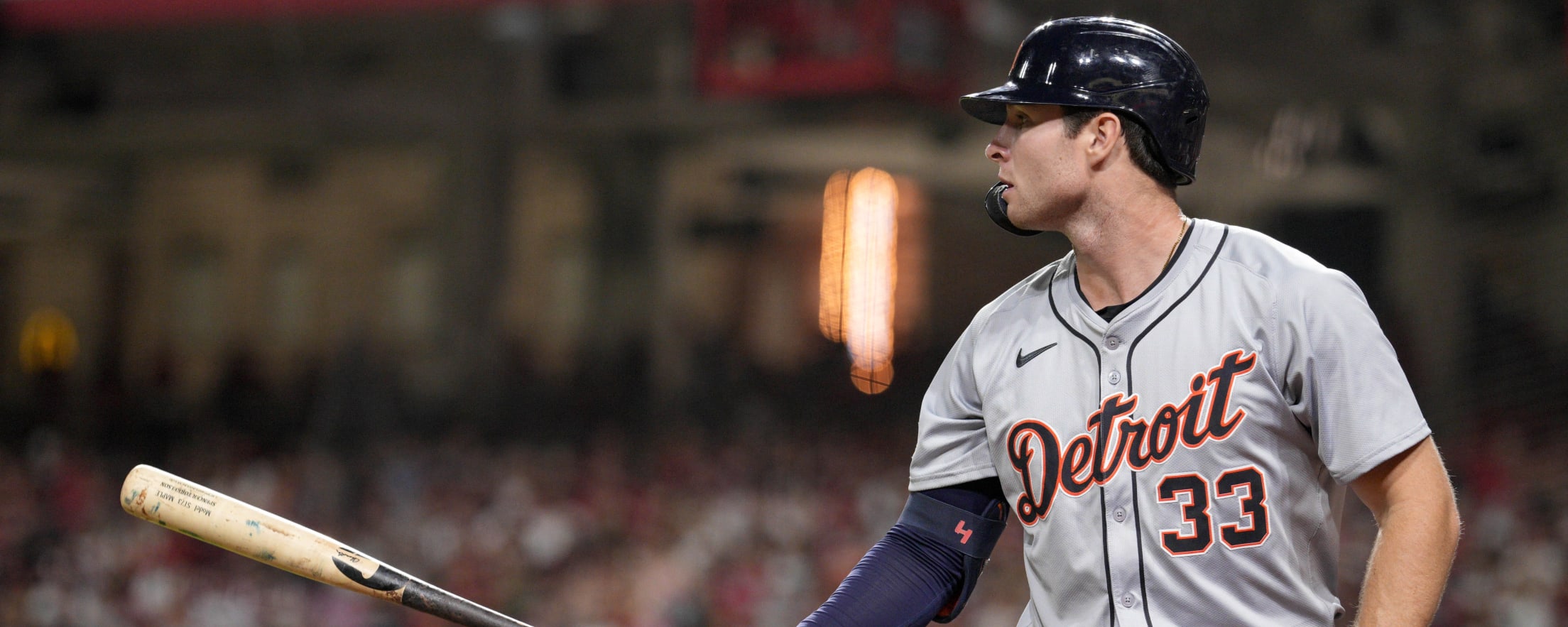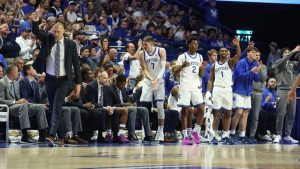
Tigers at the All-Star break: 6 takeaways from first part of 2024 season
Detroit Tigers’ Wenceel Pérez loses his helmet as he hits a single against the Houston Astros during the third inning of a baseball game Saturday, June 15, 2024, in Houston. (AP Photo/David J. Phillip)AP
DETROIT — Yes, the Detroit Tigers went into the All-Star break having won eight of their last 10 games.
But they very easily could have gone 2-8.
That’s not a slight, only an acknowledgment of the fine line that the Tigers have navigated all season long.
When the Tigers went 3-7 from June 8-18, they very easily could have gone 7-3 if four one-games had gone just a little bit differently.
Since the opening series back in March, you can follow the peaks and valleys of the Tigers by their performance in close games: When they’re winning them, it’s exhilarating. When they’re losing them, it’s demoralizing.
Tune out the noise and the Tigers are 16-16 in one-run games. They’re 5-6 in extra-inning games. They’re 16-15 in blowout games. The Tigers (47-50) are doing exactly what you’d expect a .500-ish team to be doing as they navigate the roller coaster of a 162-game regular season.
That said, there are a lot of encouraging signs to be found
The Tigers’ winning percentage at the All-Star break is better than it’s been at any point since 2016.
No, the Tigers aren’t seriously in the playoff chase. Yes, they’ll probably be aggressively trying to sell their rental pieces at the deadline in two weeks. But not everything is bleak.
Here are three takeaways from the first part of the season three key storylines for Part 2.

LOOKING BACK
1. The big three starting pitchers have been spectacular.
We’ve talked about how good the Tigers’ starting rotation has been, but we probably haven’t talked about it enough.
Tarik Skubal, Jack Flaherty and Reese Olson have combined for 312 innings over 53 starts. They have a 2.91 ERA while averaging 10.13 strikeouts and 1.9 walks per nine innings.
None of this should be taken for granted.
That Skubal would not only duplicate but actually exceed his incredible second half of 2023 was something almost too good to dream about. He’d be the AL Cy Young Winner if the season ended today.
Flaherty was signed to a one-year deal as a bounce-back candidate. He has bounced back to such a degree that he might be aiming for $100 million when he hits free agency again this winter.
It wasn’t even clear that Olson would make the team out of spring training. He was locked in a three-man race with Casey Mize and Matt Manning. But it’s safe to say the Tigers made the right call.
We haven’t even mentioned Mize, but he’s been a perfectly respectable back-of-the-rotation starter.
The only huge disappointment has been veteran free-agent Kenta Maeda.
If you subtract Maeda from the mix and count only traditional starts (not openers), the Tigers have a 3.36 ERA over 78 starts (439 innings). That’s pretty remarkable.
2. Colt Keith and Riley Greene have taken huge steps.
It’s been fun to watch Greene’s career progression.
In 2022, he was a very solid player for a 22-year-old rookie but lacked home-run power and struck out too much.
In 2023, he increased the power and started to chip away at the Ks.
In 2024, his homers are up, his walks are up and his strikeouts are way down.
He’s gone from a normal regular to an above-average player to a bonafide All-Star before our eyes.
It may seem like Keith, who is still one month away from turning 23, has gone through the same progression on fast-forward mode. But the reality is that his April wasn’t nearly as bad as the numbers made it seem.
The fact that he had the mental fortitude to get beat up by the baseball gods during his first month as a big-leaguer and respond with an outstanding May is a testament to his resilience.
Since May 1, Keith has an .846 OPS with nine homers, nine doubles and two triples in 218 plate appearances.
His defense is a work in progress, but the metrics aren’t unanimously discouraging. Statcast’s Outs Above Average, in fact, says he’s an average second baseman. And an average second baseman with an .846 OPS is a guy you want to keep at second base.
3. There were some pleasant surprises, but not enough went right to make this team a contender.
In spring training, Wenceel Perez appeared to be fighting the yips in the infield. The Tigers wisely moved him to the outfield on a full-time basis, but it appeared he was on the fringe of the 40-man roster. It wasn’t clear where he fit in the organization.
When Perez was recalled to the big-league club in April, the promotion was at least in part due to a couple of injuries ahead of him. Most thought his stint in Detroit would be short.
Three months later, Perez has 298 plate appearances, fifth-most on the club. In more than half his starts, he’s hit first, second or third in the order.
Despite the reams of data at our disposal, baseball remains quite unpredictable. Perez is a good example.
But the Tigers needed a few more pleasant surprises like Perez to break through from a .500 team to a playoff team. That didn’t happen. Veteran acquisitions Gio Urshela and Mark Canha have been useful at times but largely unspectacular. Shortstop Javier Baez’s career hasn’t recovered; in fact, things appear to be going in the opposite direction. Kerry Carpenter’s been hurt for the last six weeks, robbing the Tigers of one of their biggest bats.
The Tigers offense hasn’t been as bad as many think — it’s below the MLB average but hardly rock-bottom — but it hasn’t been good enough to spark a playoff run.
Detroit Tigers’ Jack Flaherty pitches against the Cleveland Guardians during the second inning of a baseball game Thursday, July 11, 2024, in Detroit. (AP Photo/Duane Burleson)AP
LOOKING AHEAD
1. The trade deadline will be key.
Tigers president Scott Harris has a chance to avenge the biggest disappointment of his young tenure: Getting absolutely nothing in return last summer for starting pitcher Eduardo Rodriguez.
For the second year in a row, Harris has one of the most enticing rental pieces on the market in Jack Flaherty.
Flaherty is unencumbered by the opt-out that made Rodriguez’s situation somewhat more complicated.
But he does have a pesky back injury that has flared up at an inconvenient time. The Tigers are desperate to keep him healthy and pitching until July 30 and they’ve twice rearranged their rotation to accommodate him.
After Flaherty, the Tigers have other possible trade chips but none of them are certain: In addition to Canha and Urshela; catcher Carson Kelly; and relievers Shelby Miller and Andrew Chafin could be potential trade chips. But no one in that group is likely to get much of a return.
The deadline is really Flaherty or bust.
Unless, of course, the Tigers decided to take offers on someone else…
2. Tarik Skubal’s Cy Young chase will be a reason to keep watching this summer.
The chances of the Tigers trading Skubal are very, very slim. But they’re not zero. The team most in need of a pitcher like Skubal (the Baltimore Orioles) has more prospects than it knows what to do with.
The Tigers would need a massive return to even consider dealing Skubal, who is under team control through 2026.
In the far more likely event that he sticks with the Tigers, he’ll be trying to bring a Cy Young Award to Detroit for the first time since Max Scherzer won the honors in 2013.
3. How will the Tigers align their pieces for next year?
Maybe we’ll get a few hints about the Tigers’ plans for 2025 by their actions down the stretch in 2024.
The two biggest weak spots in the Tigers’ lineup are shortstop and first base.
To be taken seriously in 2025, the Tigers must seriously seek a way to move on from Javier Baez this winter. But Baez has a chance to influence that decision with his play in the final two months of the season.
Whether in Toledo or Detroit, Spencer Torkelson could also play his way into or out of the Tigers’ 2025 plans.
Third baseman Jace Jung fits neatly into the Tigers’ 2025 Opening Day lineup in much the same way Keith did in 2024.
But will the Tigers give Jung an audition at the hot corner in August or September, or just hand over the keys next April?






